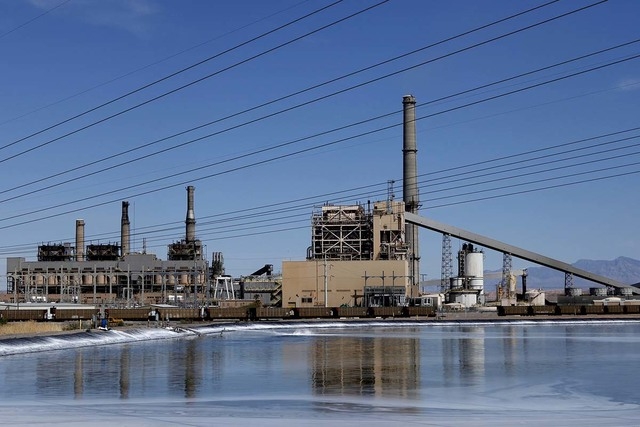Nevada has head start on new pollution rules

When it comes to meeting sweeping new federal guidelines for power plant pollution, Nevada could have an easier time than other states.
That is because the effort to cut carbon dioxide emissions was already well underway in the Silver State by the time the Environmental Protection Agency rolled out its new rules on Monday.
NV Energy, the state’s largest utility, announced plans last year to close one of two coal-burning power plants in Nevada by 2017 and give up its ownership stake in Arizona’s Navajo Generation Station by 2019 as part of a wider move away from coal.
The new EPA guidelines call on power producers nationwide to cut carbon dioxide pollution by at least 30 percent by 2030.
The rules mark the first national limits on carbon emissions from power plants, which account for about a third of all greenhouse gases released in the U.S.
Nevada’s power plants pumped out more than 14 million metric tons of carbon dioxide pollution in 2012, about the same as 3 million cars produce annually. Figuring the amount of power produced, the 2012 emission rate was 988 pounds per megawatt hour. That would be cut to 647 by 2030 if Nevada meets its EPA goal.
Officials from NV Energy and the Nevada Division of Environmental Protection said Monday they were still reviewing the 645-page proposal.
NV Energy now generates more than 80 percent of its power from cleaner-burning natural gas, which emits roughly half as much carbon dioxide as do traditional coal plants.
The utility also draws power from 39 renewable energy projects across the state, including some that date back to the mid 1980s. Its newest renewable project, the 110 megawatt Crescent Dunes Solar array, is now under construction near Tonopah, and more are planned as NV Energy looks to replace the generating capacity it will lose by closing its Reid Gardner coal-burning plant north of Las Vegas and giving up its 11 percent share in the Navajo plant.
The Obama administration’s latest environmental initiative drew mixed reactions across the country, and Nevada’s congressional delegation was no exception.
Sen. Harry Reid, who has used his influence to speed a Nevada transition away from coal, applauded the plan for states to further cut power plant carbon pollution.
“The EPA’s proposed plan is a crucial step towards improving the efficiency of our nations power grid, investing in clean energy and reducing pollution,” the Nevada Democrat and Senate majority leader said in a statement. “Addressing climate change, cutting pollution, and creating jobs through clean energy is the right thing to do.”
Rep. Steve Horsford, D-Nev., echoed that sentiment, calling climate change “a serious threat to our national security” requiring immediate action.
But Sen. Dean Heller, R-Nev., said he worries about what the proposal could to do to energy costs that are already far too high.
“(Heller) is concerned both about this administration’s aggressive regulatory agenda and the higher costs that these overly burdensome regulations will impose on middle-class Americans,” said Chandler Smith, spokeswoman for Heller.
The EPA is leaving it to states to come up with their own plans to meet individualized targets, which will vary across the nation. States will have until 2017 and in some cases 2018 to submit cleanup plans.
Lydia Ball is executive director for the Clean Energy Project, a nonprofit, nonpartisan group that promotes investment in energy efficiency and renewable energy in Nevada and the West.
She said “the devil is in the details” of a such a huge policy change, but she thinks Nevada is in an ideal spot to not only meet the new standard but profit from it.
“I think we’re in a very good position to comply. I think there’s going to be room left over to give us the ability to send our resources into other states,” Ball said. “It’s only going to create more demand for our natural resources.”
Ball said the transformation of Nevada’s power sector began almost 20 years ago, when it became one of the first states to adopt a renewable energy portfolio standard.
That standard has been modified several times since then and now requires at least 25 percent of the state’s power to come from renewable sources by 2025.
The real shift has come more recently, as Nevada moved away from importing most of its energy and the fossil fuels needed to generate it, a policy she said sent an estimated $1.7 billion out of the state.
“We weren’t investing in the resources we were blessed with,” she said, namely wind, sunshine and geothermal energy.
Since then, Nevada has become a national leader in reducing carbon pollution by retiring old coal-burning plants and sparking investment in renewable replacements with $500 million in tax abatements in the past four years alone, Ball said.
So far those incentives have produced a 10-to-1 return by attracting $5.5 billion worth of private solar, wind and geothermal projects to Nevada, she said.
The new federal guidelines for carbon dioxide pollution from power plants can be found on the Web at www2.epa.gov/carbon-pollution-standards.
The website also includes information about how the public can comment on the proposed rules.
Review-Journal writer Steve Tetreault and the Associated Press contributed to this report. Contact Henry Brean at hbrean@reviewjournal.com or 702-383-0350. Follow @RefriedBrean on Twitter.